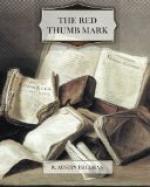“Accordingly, gentlemen, I assert that the prisoner’s innocence has been proved in the most complete and convincing manner, and I ask you for a verdict in accordance with that proof.”
As Anstey resumed his seat, a low rumble of applause was heard from the gallery. It subsided instantly on a gesture of disapproval from the judge, and a silence fell upon the court, in which the clock, with cynical indifference, continued to record in its brusque monotone the passage of the fleeting seconds.
“He is saved, Dr. Jervis! Oh! surely he is saved!” Juliet exclaimed in an agitated whisper. “They must see that he is innocent now.”
“Have patience a little longer,” I answered. “It will soon be over now.”
Sir Hector Trumpler was already on his feet and, after bestowing on the jury a stern hypnotic stare, he plunged into his reply with a really admirable air of conviction and sincerity. “My lord and gentlemen of the jury: The case which is now before this Court is one, as I have already remarked, in which human nature is presented in a highly unfavourable light. But I need not insist upon this aspect of the case, which will already, no doubt, have impressed you sufficiently. It is necessary merely for me, as my learned friend has aptly expressed it, to disentangle the actual facts of the case from the web of casuistry that has been woven around them.
“Those facts are of extreme simplicity. A safe has been opened and property of great value abstracted from it. It has been opened by means of false keys. Now there are two men who have, from time to time, had possession of the true keys, and thus had the opportunity of making copies of them. When the safe is opened by its rightful owner, the property is gone, and there is found the print of the thumb of one of these two men. That thumb-print was not there when the safe was closed. The man whose thumb-print is found is a left-handed man; the print is the print of a left thumb. It would seem, gentlemen, as if the conclusion were so obvious that no sane person could be found to contest it; and I submit that the conclusion which any sane person would arrive at—the only possible conclusion—is, that the person whose thumb-print was found in the safe is the person who stole the property from the safe. But the thumb-print was, admittedly, that of the prisoner at the bar, and therefore the prisoner at the bar is the person who stole the diamonds from the safe.
“It is true that certain fantastic attempts have been made to explain away these obvious facts. Certain far-fetched scientific theories have been propounded and an exhibition of legerdemain has taken place which, I venture to think, would have been more appropriate to some place of public entertainment than to a court of justice. That exhibition has, no doubt, afforded you considerable amusement. It has furnished a pleasing relaxation from the serious business of the court. It has even been instructive,




